| Example |
Size
of File |
Locality |
Characteristics |
Interpretation |
 |
Fig.38, 5/26 kb |
Central Portugal, Consolação |
Reef meadow composed of one single coral species (Calamophylliopsis) |
Stress environment directly at the coast, plagued by frequent storms and sedimentation events |
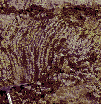 |
Fig.39, 6/29 kb |
Central Portugal, Gosundeira |
A large branching coral colony (Ovalastrea plicata) from a reef composed of many different coral species |
Optimum growth conditions in shallow waters without sedimentation stress |
 |
Fig.40, 9/30 kb |
Eastern Spain, Jabaloyas |
Coral reefs with pronounced relief are restricted to a distinct horizon |
Optimum growth condition in shallow waters only during a certain time episode which is represented by the reef horizon |
 |
Fig.41, 12/48 kb |
Eastern Spain, Jabaloyas |
A coral reef from above horizon. The coral reef contains a high amount of microbial crust and exhibits a pronounced relief |
Optimum growth conditions in shallow waters without sedimentation stress |
 |
Fig.42, 6/18 kb |
Southern Portugal, Lagoa dos Cavalos |
Coral meadow composed of one single, branching coral species (Actinastrea ramulifera) |
Only short-termed growth in shallow water, truncated by storm |
 |
Fig.43, 8/39 kb |
Southern Portugal, Conceicao |
Coral reef composed of many different massive corals overgrowing each other |
Optimum growth conditions in shallow waters of fairly high (but not too high) water energy |
 |
Fig.44, 9/41 kb |
Central Portugal, Arruda dos Vinhos |
Coral reef made of different coral species. Dish-shaped colonies (Microsolena, arrow) and solitary corals growing on top of each other (Trocharea cf. gregoryi, V-mark) are particularly frequent |
The relatively high proportion of dish-shaped coral colonies and the occurrence of certain siliceous sponges indicate slightly deeper waters. Nevertheless, species richness is fairly high |
 |
Fig.45, 7/25 kb |
Southern Portugal, Tavira |
Coral reef containing numerous siliceous sponges (not visible at this scale). Arrows point to the colonies of the predominant, up to one meter large, dish-shaped flower coral species. |
The very reduced species number, the exclusive occurrence of dish-shaped corals (cf. Microsolena) adapted to low illumination, and the frequent occurrence of siliceous sponges indicate growth in waters several tens of meters deep. This is at the lower margin of growth of reef corals. |
| Example |
Size of
File |
Locality |
Characteristics |
Interpretation |
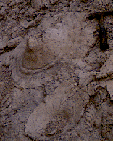 |
Fig.46, 18/17 kb |
Northern Switzerland nearby Basel |
Sponge meadow composed of large, dish-shaped siliceous sponges |
Relatively good growth conditions in water depths of several tens of meters. |
 |
Fig.47, 4/36 kb |
Southwestern Germany, Gosheim |
Large sponge reef composed of microbial crusts, siliceous sponges and calcareous mud |
Good growth conditions in waters several tens of meters deep. Occasional, but generally low sediment influx was collected by microbial films and helped the reef mound to build up. |
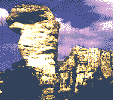 |
Fig.48, 7/22 kb |
Polen, nearby Tschenstochau |
Spectacular sceneries are formed by relics of Jurassic sponge reefs. This rock formation does not correspond to the original reef morphologies. Comparable reef relics exist in southern Germany (Swabian and Franconian Alb). |
Growth conditions as in the above example |
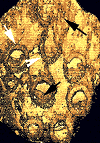 |
Fig.49, 7/20 kb |
Southwestern Germany, nearby Münsingen |
Polished rock slab shows the typical composition of these reefs. White arrows: Sections across tube-shaped siliceous sponges. Black arrows: Microbial crusts within and at the outer side of sponges. Rest of rock is composed of former calcareous mud |
Growth conditions as in the two previous examples |
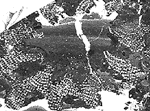 |
Fig.50, 8/28 kb |
Southern Portugal, Alfarrobeira |
Thin-section microphotograph of a sponge limestone. Clearly visible is the netlike sponge-needle (spicula) skeleton of a siliceous sponge. Dark dots and streaks represent microbial crusts or their reworked remnants. Light gray colored material (rest of photo) represents former calcareous mud |
|
| Example |
File
Size |
Locality |
Characteristics |
Interpretation |
 |
Fig.51, 5/37 kb |
Southern Portugal, Cotovio |
A conical small reef almost exclusively composed of microbial crusts |
Accompanying organisms (especially ammonites and belemnites) indicate open marine conditions in somewhat deeper water. Bottom waters were depleted with oxygen, so that most other bottom dwellers such as siliceous sponges could not - or only very sporadically - grow there. |
 |
Fig.52, 5/40 kb |
same locality as above |
Top view of the club-shaped little microbial crust reefs positioned close to each other. The polygon pattern results from this crowded occurrence of reef bodies |
|
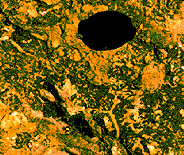 |
Fig.53, 12 kb |
same locality as above |
Formation of glauconite (green) at the top surface of a microbial crust reef. The mineral which forms at the sea floor under partial lack of oxygen contains reduced iron which causes its green color. |
|
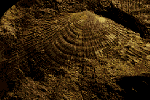 |
Fig.54, 6/21 |
Central Portugal, Arruda dos Vinhos |
The clam Aulacomyella abadiensis dwelled on Jurassic sea floors and occurs occasionally in the pure microbial crust reefs |
It is known that this clam lived exclusively under very reduced oxygen concentration and therefore represents a perfect indicator for episodes of oxygen depletion. This is in contrast with the microbial crusts which could grow with or without oxygen |
 |
Fig.55, 3/16 |
Southern Portugal, Cotovio |
Polished rock slab from a microbial crust reef. Crusts form the reef framework. Calcareous mud settled down in some small cavities. Greenish colors are due to glauconite, a mineral which forms under oxygen depletion at the sea floor. |
|
 |
Fig.56, 5/16 kb |
Southern Portugal, Rocha |
Microscopic, largely magnified photograph of a microbial crust. The dark particles with irregular outlines represent calcified sugary slimes produced by microbes. Their arrangements in filaments is occasionally still visible (arrow). |
|